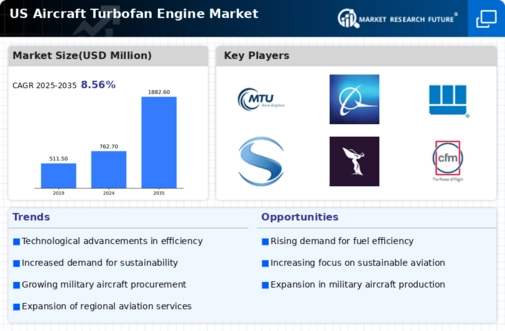The competitive landscape of the US Aircraft Turbofan Engine Market is characterized by a dynamic interplay of several leading manufacturers and emerging players, each vying for market share through innovation, advanced technology, and strategic partnerships. The market is marked by the demand for efficiency, sustainability, and high-performance engines, driven by the growing fleet of commercial aircraft and military operations. Companies are increasingly investing in research and development to enhance fuel efficiency, minimize emissions, and improve overall performance, responding to regulatory pressures and customer demands for greener technologies.
As a result, collaborations and strategic alliances among industry players are on the rise, contributing to a rapidly evolving market scenario.MTU Aero Engines has established itself as a prominent player within the US Aircraft Turbofan Engine Market, recognized for its cutting-edge engine technologies and commitment to excellence. The company boasts a strong market presence fueled by its expertise in the design, development, and production of high-thrust engines. MTU Aero Engines focuses on products that emphasize reliability and fuel efficiency, enhancing the operational capabilities of various aircraft.
Its manufacturing facilities are equipped with state-of-the-art technologies that allow for precise engineering and quality control. Additionally, MTU's collaborative approaches, including partnerships with key stakeholders, strengthen its market positioning while enabling it to leverage synergies in innovation and production, ensuring sustained growth in the competitive landscape of turbofan engines.Boeing operates as a major influencer in the US Aircraft Turbofan Engine Market, leveraging its vast experience in aerospace engineering and manufacturing. The company offers a diverse portfolio of products, including jet engines that are renowned for their high performance and operational efficiency.
Boeing's strengths lie in its robust market presence, extensive distribution network, and strong relationships with airlines and military organizations across the United States. The company has also engaged in strategic mergers and acquisitions to enhance its technological capabilities and expand its product offerings within the turbofan segment. Boeing's investment in next-generation technologies reflects its commitment to sustainability and innovation, allowing it to maintain a competitive edge.
By integrating advanced aerodynamics and materials science into its engine designs, Boeing continues to be a significant contributor to the enhancement of propulsion systems in both commercial aviation and defense sectors in the US region.






















Leave a Comment